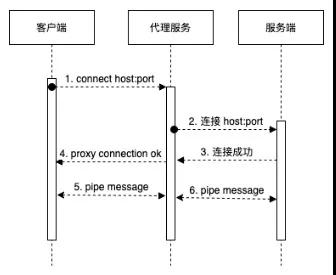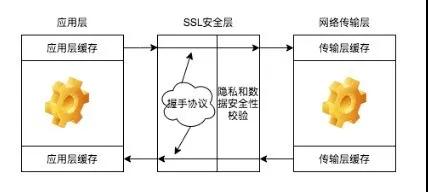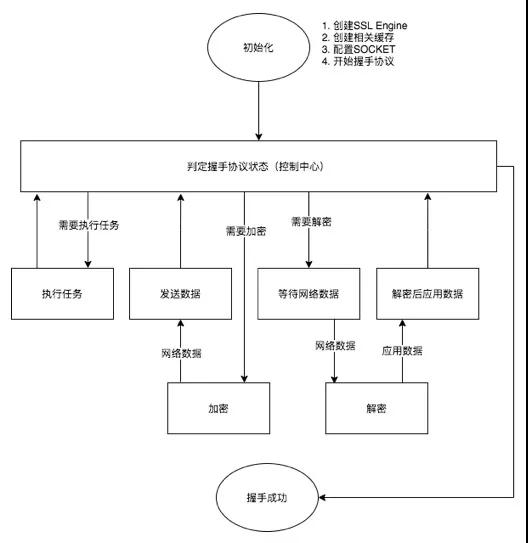一、問題背景
平臺端購置一批裸代理,來做廣告異地展現(xiàn)審核。從外部購置的代理,使用方式為:
- 通過給定的HTTP 的 API 提取代理 IP:PORT,返回的結果會給出代理的有效時長 3~5 分鐘,以及代理所屬地域;
- 從提取的代理中,選取指定地域,添加認證信息,請求獲取結果;
本文設計實現(xiàn)一個通過的代理網關:
- 管理維護代理資源,并做代理的認證鑒權;
- 對外暴露統(tǒng)一的代理入口,而非動態(tài)變化的代理IP:PORT;
- 流量過濾及限流,比如:靜態(tài)資源不走代理;
本文重點在代理網關本身的設計與實現(xiàn),而非代理資源的管理與維護。
注:本文包含大量可執(zhí)行的JAVA代碼以解釋代理相關的原理
二、技術路線
本文的技術路線。在現(xiàn)代理網關之前,首先介紹下代理相關的原理及如何實現(xiàn)
- 透明代理;
- 非透明代理;
- 透明的上游代理;
- 非透明的上游代理;
最后,本文要構建代理網關,本質上就是一個非透明的上游代理,并給出詳細的設計與實現(xiàn)。
1.透明代理
透明代理是代理網關的基礎,本文采用JAVA原生的NIO進行詳細介紹。在實現(xiàn)代理網關時,實際使用的為NETTY框架。原生NIO的實現(xiàn)對理解NETTY的實現(xiàn)有幫助。
透明代理設計三個交互方,客戶端、代理服務、服務端,其原理是:
??
??
- 代理服務在收到連接請求時,判定:如果是CONNECT請求,需要回應代理連接成功消息到客戶端;
- CONNECT請求回應結束后,代理服務需要連接到CONNECT指定的遠程服務器,然后直接轉發(fā)客戶端和遠程服務通信;
- 代理服務在收到非CONNECT請求時,需要解析出請求的遠程服務器,然后直接轉發(fā)客戶端和遠程服務通信;
需要注意的點是:
- 通常HTTPS請求,在通過代理前,會發(fā)送CONNECT請求;連接成功后,會在信道上進行加密通信的握手協(xié)議;因此連接遠程的時機是在CONNECT請求收到時,因為此后是加密數(shù)據;
- 透明代理在收到CONNECT請求時,不需要傳遞到遠程服務(遠程服務不識別此請求);
- 透明代理在收到非CONNECT請求時,要無條件轉發(fā);
完整的透明代理的實現(xiàn)不到約300行代碼,完整摘錄如下:
@Slf4j
public class SimpleTransProxy {
public static void main(String[] args) throws IOException {
int port = 8006;
ServerSocketChannel localServer = ServerSocketChannel.open();
localServer.bind(new InetSocketAddress(port));
Reactor reactor = new Reactor();
// REACTOR線程
GlobalThreadPool.REACTOR_EXECUTOR.submit(reactor::run);
// WORKER單線程調試
while (localServer.isOpen()) {
// 此處阻塞等待連接
SocketChannel remoteClient = localServer.accept();
// 工作線程
GlobalThreadPool.WORK_EXECUTOR.submit(new Runnable() {
@SneakyThrows
@Override
public void run() {
// 代理到遠程
SocketChannel remoteServer = new ProxyHandler().proxy(remoteClient);
// 透明傳輸
reactor.pipe(remoteClient, remoteServer)
.pipe(remoteServer, remoteClient);
}
});
}
}
}
@Data
class ProxyHandler {
private String method;
private String host;
private int port;
private SocketChannel remoteServer;
private SocketChannel remoteClient;
/**
* 原始信息
*/
private List<ByteBuffer> buffers = new ArrayList<>();
private StringBuilder stringBuilder = new StringBuilder();
/**
* 連接到遠程
* @param remoteClient
* @return
* @throws IOException
*/
public SocketChannel proxy(SocketChannel remoteClient) throws IOException {
this.remoteClient = remoteClient;
connect();
return this.remoteServer;
}
public void connect() throws IOException {
// 解析METHOD, HOST和PORT
beforeConnected();
// 鏈接REMOTE SERVER
createRemoteServer();
// CONNECT請求回應,其他請求WRITE THROUGH
afterConnected();
}
protected void beforeConnected() throws IOException {
// 讀取HEADER
readAllHeader();
// 解析HOST和PORT
parseRemoteHostAndPort();
}
/**
* 創(chuàng)建遠程連接
* @throws IOException
*/
protected void createRemoteServer() throws IOException {
remoteServer = SocketChannel.open(new InetSocketAddress(host, port));
}
/**
* 連接建立后預處理
* @throws IOException
*/
protected void afterConnected() throws IOException {
// 當CONNECT請求時,默認寫入200到CLIENT
if ("CONNECT".equalsIgnoreCase(method)) {
// CONNECT默認為443端口,根據HOST再解析
remoteClient.write(ByteBuffer.wrap("HTTP/1.0 200 Connection Established\r\nProxy-agent: nginx\r\n\r\n".getBytes()));
} else {
writeThrouth();
}
}
protected void writeThrouth() {
buffers.forEach(byteBuffer -> {
try {
remoteServer.write(byteBuffer);
} catch (IOException e) {
e.printStackTrace();
}
});
}
/**
* 讀取請求內容
* @throws IOException
*/
protected void readAllHeader() throws IOException {
while (true) {
ByteBuffer clientBuffer = newByteBuffer();
int read = remoteClient.read(clientBuffer);
clientBuffer.flip();
appendClientBuffer(clientBuffer);
if (read < clientBuffer.capacity()) {
break;
}
}
}
/**
* 解析出HOST和PROT
* @throws IOException
*/
protected void parseRemoteHostAndPort() throws IOException {
// 讀取第一批,獲取到METHOD
method = parseRequestMethod(stringBuilder.toString());
// 默認為80端口,根據HOST再解析
port = 80;
if ("CONNECT".equalsIgnoreCase(method)) {
port = 443;
}
this.host = parseHost(stringBuilder.toString());
URI remoteServerURI = URI.create(host);
host = remoteServerURI.getHost();
if (remoteServerURI.getPort() > 0) {
port = remoteServerURI.getPort();
}
}
protected void appendClientBuffer(ByteBuffer clientBuffer) {
buffers.add(clientBuffer);
stringBuilder.append(new String(clientBuffer.array(), clientBuffer.position(), clientBuffer.limit()));
}
protected static ByteBuffer newByteBuffer() {
// buffer必須大于7,保證能讀到method
return ByteBuffer.allocate(128);
}
private static String parseRequestMethod(String rawContent) {
// create uri
return rawContent.split("\r\n")[0].split(" ")[0];
}
private static String parseHost(String rawContent) {
String[] headers = rawContent.split("\r\n");
String host = "host:";
for (String header : headers) {
if (header.length() > host.length()) {
String key = header.substring(0, host.length());
String value = header.substring(host.length()).trim();
if (host.equalsIgnoreCase(key)) {
if (!value.startsWith("http://") && !value.startsWith("https://")) {
value = "http://" + value;
}
return value;
}
}
}
return "";
}
}
@Slf4j
@Data
class Reactor {
private Selector selector;
private volatile boolean finish = false;
@SneakyThrows
public Reactor() {
selector = Selector.open();
}
@SneakyThrows
public Reactor pipe(SocketChannel from, SocketChannel to) {
from.configureBlocking(false);
from.register(selector, SelectionKey.OP_READ, new SocketPipe(this, from, to));
return this;
}
@SneakyThrows
public void run() {
try {
while (!finish) {
if (selector.selectNow() > 0) {
Iterator<SelectionKey> it = selector.selectedKeys().iterator();
while (it.hasNext()) {
SelectionKey selectionKey = it.next();
if (selectionKey.isValid() && selectionKey.isReadable()) {
((SocketPipe) selectionKey.attachment()).pipe();
}
it.remove();
}
}
}
} finally {
close();
}
}
@SneakyThrows
public synchronized void close() {
if (finish) {
return;
}
finish = true;
if (!selector.isOpen()) {
return;
}
for (SelectionKey key : selector.keys()) {
closeChannel(key.channel());
key.cancel();
}
if (selector != null) {
selector.close();
}
}
public void cancel(SelectableChannel channel) {
SelectionKey key = channel.keyFor(selector);
if (Objects.isNull(key)) {
return;
}
key.cancel();
}
@SneakyThrows
public void closeChannel(Channel channel) {
SocketChannel socketChannel = (SocketChannel)channel;
if (socketChannel.isConnected() && socketChannel.isOpen()) {
socketChannel.shutdownOutput();
socketChannel.shutdownInput();
}
socketChannel.close();
}
}
@Data
@AllArgsConstructor
class SocketPipe {
private Reactor reactor;
private SocketChannel from;
private SocketChannel to;
@SneakyThrows
public void pipe() {
// 取消監(jiān)聽
clearInterestOps();
GlobalThreadPool.PIPE_EXECUTOR.submit(new Runnable() {
@SneakyThrows
@Override
public void run() {
int totalBytesRead = 0;
ByteBuffer byteBuffer = ByteBuffer.allocate(1024);
while (valid(from) && valid(to)) {
byteBuffer.clear();
int bytesRead = from.read(byteBuffer);
totalBytesRead = totalBytesRead + bytesRead;
byteBuffer.flip();
to.write(byteBuffer);
if (bytesRead < byteBuffer.capacity()) {
break;
}
}
if (totalBytesRead < 0) {
reactor.closeChannel(from);
reactor.cancel(from);
} else {
// 重置監(jiān)聽
resetInterestOps();
}
}
});
}
protected void clearInterestOps() {
from.keyFor(reactor.getSelector()).interestOps(0);
to.keyFor(reactor.getSelector()).interestOps(0);
}
protected void resetInterestOps() {
from.keyFor(reactor.getSelector()).interestOps(SelectionKey.OP_READ);
to.keyFor(reactor.getSelector()).interestOps(SelectionKey.OP_READ);
}
private boolean valid(SocketChannel channel) {
return channel.isConnected() && channel.isRegistered() && channel.isOpen();
}
}
以上,借鑒NETTY:
- 首先初始化REACTOR線程,然后開啟代理監(jiān)聽,當收到代理請求時處理。
- 代理服務在收到代理請求時,首先做代理的預處理,然后又SocketPipe做客戶端和遠程服務端雙向轉發(fā)。
- 代理預處理,首先讀取第一個HTTP請求,解析出METHOD, HOST, PORT。
- 如果是CONNECT請求,發(fā)送回應Connection Established,然后連接遠程服務端,并返回SocketChannel
- 如果是非CONNECT請求,連接遠程服務端,寫入原始請求,并返回SocketChannel
- SocketPipe在客戶端和遠程服務端,做雙向的轉發(fā);其本身是將客戶端和服務端的SocketChannel注冊到REACTOR
- REACTOR在監(jiān)測到READABLE的CHANNEL,派發(fā)給SocketPipe做雙向轉發(fā)。
測試
代理的測試比較簡單,指向代碼后,代理服務監(jiān)聽8006端口,此時:
curl -x 'localhost:8006' http://httpbin.org/get測試HTTP請求
curl -x 'localhost:8006' https://httpbin.org/get測試HTTPS請求
注意,此時代理服務代理了HTTPS請求,但是并不需要-k選項,指示非安全的代理。因為代理服務本身并沒有作為一個中間人,并沒有解析出客戶端和遠程服務端通信的內容。在非透明代理時,需要解決這個問題。
2.非透明代理
非透明代理,需要解析出客戶端和遠程服務端傳輸?shù)膬热荩⒆鱿鄳奶幚怼?/p>
當傳輸為HTTP協(xié)議時,SocketPipe傳輸?shù)臄?shù)據即為明文的數(shù)據,可以攔截后直接做處理。
當傳輸為HTTPS協(xié)議時,SocketPipe傳輸?shù)挠行?shù)據為加密數(shù)據,并不能透明處理。
另外,無論是傳輸?shù)腍TTP協(xié)議還是HTTPS協(xié)議,SocketPipe讀到的都為非完整的數(shù)據,需要做聚批的處理。
SocketPipe聚批問題,可以采用類似BufferedInputStream對InputStream做Decorate的模式來實現(xiàn),相對比較簡單;詳細可以參考NETTY的HttpObjectAggregator;
HTTPS原始請求和結果數(shù)據的加密和解密的處理,需要實現(xiàn)的NIO的SOCKET CHANNEL;
SslSocketChannel封裝原理
考慮到目前JDK自帶的NIO的SocketChannel并不支持SSL;已有的SSLSocket是阻塞的OIO。如圖:
??
??
可以看出
- 每次入站數(shù)據和出站數(shù)據都需要 SSL SESSION 做握手;
- 入站數(shù)據做解密,出站數(shù)據做加密;
- 握手,數(shù)據加密和數(shù)據解密是統(tǒng)一的一套狀態(tài)機;
??
??
以下,代碼實現(xiàn) SslSocketChannel
public class SslSocketChannel {
/**
* 握手加解密需要的四個存儲
*/
protected ByteBuffer myAppData; // 明文
protected ByteBuffer myNetData; // 密文
protected ByteBuffer peerAppData; // 明文
protected ByteBuffer peerNetData; // 密文
/**
* 握手加解密過程中用到的異步執(zhí)行器
*/
protected ExecutorService executor = Executors.newSingleThreadExecutor();
/**
* 原NIO 的 CHANNEL
*/
protected SocketChannel socketChannel;
/**
* SSL 引擎
*/
protected SSLEngine engine;
public SslSocketChannel(SSLContext context, SocketChannel socketChannel, boolean clientMode) throws Exception {
// 原始的NIO SOCKET
this.socketChannel = socketChannel;
// 初始化BUFFER
SSLSession dummySession = context.createSSLEngine().getSession();
myAppData = ByteBuffer.allocate(dummySession.getApplicationBufferSize());
myNetData = ByteBuffer.allocate(dummySession.getPacketBufferSize());
peerAppData = ByteBuffer.allocate(dummySession.getApplicationBufferSize());
peerNetData = ByteBuffer.allocate(dummySession.getPacketBufferSize());
dummySession.invalidate();
engine = context.createSSLEngine();
engine.setUseClientMode(clientMode);
engine.beginHandshake();
}
/**
* 參考 https://docs.oracle.com/javase/8/docs/technotes/guides/security/jsse/JSSERefGuide.html
* 實現(xiàn)的 SSL 的握手協(xié)議
* @return
* @throws IOException
*/
protected boolean doHandshake() throws IOException {
SSLEngineResult result;
HandshakeStatus handshakeStatus;
int appBufferSize = engine.getSession().getApplicationBufferSize();
ByteBuffer myAppData = ByteBuffer.allocate(appBufferSize);
ByteBuffer peerAppData = ByteBuffer.allocate(appBufferSize);
myNetData.clear();
peerNetData.clear();
handshakeStatus = engine.getHandshakeStatus();
while (handshakeStatus != HandshakeStatus.FINISHED && handshakeStatus != HandshakeStatus.NOT_HANDSHAKING) {
switch (handshakeStatus) {
case NEED_UNWRAP:
if (socketChannel.read(peerNetData) < 0) {
if (engine.isInboundDone() && engine.isOutboundDone()) {
return false;
}
try {
engine.closeInbound();
} catch (SSLException e) {
log.debug("收到END OF STREAM,關閉連接.", e);
}
engine.closeOutbound();
handshakeStatus = engine.getHandshakeStatus();
break;
}
peerNetData.flip();
try {
result = engine.unwrap(peerNetData, peerAppData);
peerNetData.compact();
handshakeStatus = result.getHandshakeStatus();
} catch (SSLException sslException) {
engine.closeOutbound();
handshakeStatus = engine.getHandshakeStatus();
break;
}
switch (result.getStatus()) {
case OK:
break;
case BUFFER_OVERFLOW:
peerAppData = enlargeApplicationBuffer(engine, peerAppData);
break;
case BUFFER_UNDERFLOW:
peerNetData = handleBufferUnderflow(engine, peerNetData);
break;
case CLOSED:
if (engine.isOutboundDone()) {
return false;
} else {
engine.closeOutbound();
handshakeStatus = engine.getHandshakeStatus();
break;
}
default:
throw new IllegalStateException("無效的握手狀態(tài): " + result.getStatus());
}
break;
case NEED_WRAP:
myNetData.clear();
try {
result = engine.wrap(myAppData, myNetData);
handshakeStatus = result.getHandshakeStatus();
} catch (SSLException sslException) {
engine.closeOutbound();
handshakeStatus = engine.getHandshakeStatus();
break;
}
switch (result.getStatus()) {
case OK :
myNetData.flip();
while (myNetData.hasRemaining()) {
socketChannel.write(myNetData);
}
break;
case BUFFER_OVERFLOW:
myNetData = enlargePacketBuffer(engine, myNetData);
break;
case BUFFER_UNDERFLOW:
throw new SSLException("加密后消息內容為空,報錯");
case CLOSED:
try {
myNetData.flip();
while (myNetData.hasRemaining()) {
socketChannel.write(myNetData);
}
peerNetData.clear();
} catch (Exception e) {
handshakeStatus = engine.getHandshakeStatus();
}
break;
default:
throw new IllegalStateException("無效的握手狀態(tài): " + result.getStatus());
}
break;
case NEED_TASK:
Runnable task;
while ((task = engine.getDelegatedTask()) != null) {
executor.execute(task);
}
handshakeStatus = engine.getHandshakeStatus();
break;
case FINISHED:
break;
case NOT_HANDSHAKING:
break;
default:
throw new IllegalStateException("無效的握手狀態(tài): " + handshakeStatus);
}
}
return true;
}
/**
* 參考 https://docs.oracle.com/javase/8/docs/technotes/guides/security/jsse/JSSERefGuide.html
* 實現(xiàn)的 SSL 的傳輸讀取協(xié)議
* @param consumer
* @throws IOException
*/
public void read(Consumer<ByteBuffer> consumer) throws IOException {
// BUFFER初始化
peerNetData.clear();
int bytesRead = socketChannel.read(peerNetData);
if (bytesRead > 0) {
peerNetData.flip();
while (peerNetData.hasRemaining()) {
peerAppData.clear();
SSLEngineResult result = engine.unwrap(peerNetData, peerAppData);
switch (result.getStatus()) {
case OK:
log.debug("收到遠程的返回結果消息為:" + new String(peerAppData.array(), 0, peerAppData.position()));
consumer.accept(peerAppData);
peerAppData.flip();
break;
case BUFFER_OVERFLOW:
peerAppData = enlargeApplicationBuffer(engine, peerAppData);
break;
case BUFFER_UNDERFLOW:
peerNetData = handleBufferUnderflow(engine, peerNetData);
break;
case CLOSED:
log.debug("收到遠程連接關閉消息.");
closeConnection();
return;
default:
throw new IllegalStateException("無效的握手狀態(tài): " + result.getStatus());
}
}
} else if (bytesRead < 0) {
log.debug("收到END OF STREAM,關閉連接.");
handleEndOfStream();
}
}
public void write(String message) throws IOException {
write(ByteBuffer.wrap(message.getBytes()));
}
/**
* 參考 https://docs.oracle.com/javase/8/docs/technotes/guides/security/jsse/JSSERefGuide.html
* 實現(xiàn)的 SSL 的傳輸寫入協(xié)議
* @param message
* @throws IOException
*/
public void write(ByteBuffer message) throws IOException {
myAppData.clear();
myAppData.put(message);
myAppData.flip();
while (myAppData.hasRemaining()) {
myNetData.clear();
SSLEngineResult result = engine.wrap(myAppData, myNetData);
switch (result.getStatus()) {
case OK:
myNetData.flip();
while (myNetData.hasRemaining()) {
socketChannel.write(myNetData);
}
log.debug("寫入遠程的消息為: {}", message);
break;
case BUFFER_OVERFLOW:
myNetData = enlargePacketBuffer(engine, myNetData);
break;
case BUFFER_UNDERFLOW:
throw new SSLException("加密后消息內容為空.");
case CLOSED:
closeConnection();
return;
default:
throw new IllegalStateException("無效的握手狀態(tài): " + result.getStatus());
}
}
}
/**
* 關閉連接
* @throws IOException
*/
public void closeConnection() throws IOException {
engine.closeOutbound();
doHandshake();
socketChannel.close();
executor.shutdown();
}
/**
* END OF STREAM(-1)默認是關閉連接
* @throws IOException
*/
protected void handleEndOfStream() throws IOException {
try {
engine.closeInbound();
} catch (Exception e) {
log.error("END OF STREAM 關閉失敗.", e);
}
closeConnection();
}
}以上:
- 基于 SSL 協(xié)議,實現(xiàn)統(tǒng)一的握手動作;
- 分別實現(xiàn)讀取的解密,和寫入的加密方法;
- 將 SslSocketChannel 實現(xiàn)為 SocketChannel的Decorator;
SslSocketChannel測試服務端
基于以上封裝,簡單測試服務端如下:
@Slf4j
public class NioSslServer {
public static void main(String[] args) throws Exception {
NioSslServer sslServer = new NioSslServer("127.0.0.1", 8006);
sslServer.start()
// 使用 curl -vv -k 'https://localhost:8006' 連接
}
private SSLContext context;
private Selector selector;
public NioSslServer(String hostAddress, int port) throws Exception {
// 初始化SSL Context
context = serverSSLContext();
// 注冊監(jiān)聽器
selector = SelectorProvider.provider().openSelector();
ServerSocketChannel serverSocketChannel = ServerSocketChannel.open();
serverSocketChannel.configureBlocking(false);
serverSocketChannel.socket().bind(new InetSocketAddress(hostAddress, port));
serverSocketChannel.register(selector, SelectionKey.OP_ACCEPT);
}
public void start() throws Exception {
log.debug("等待連接中.");
while (true) {
selector.select();
Iterator<SelectionKey> selectedKeys = selector.selectedKeys().iterator();
while (selectedKeys.hasNext()) {
SelectionKey key = selectedKeys.next();
selectedKeys.remove();
if (!key.isValid()) {
continue;
}
if (key.isAcceptable()) {
accept(key);
} else if (key.isReadable()) {
((SslSocketChannel)key.attachment()).read(buf->{});
// 直接回應一個OK
((SslSocketChannel)key.attachment()).write("HTTP/1.1 200 OK\r\nContent-Type: text/plain\r\n\r\nOK\r\n\r\n");
((SslSocketChannel)key.attachment()).closeConnection();
}
}
}
}
private void accept(SelectionKey key) throws Exception {
log.debug("接收新的請求.");
SocketChannel socketChannel = ((ServerSocketChannel)key.channel()).accept();
socketChannel.configureBlocking(false);
SslSocketChannel sslSocketChannel = new SslSocketChannel(context, socketChannel, false);
if (sslSocketChannel.doHandshake()) {
socketChannel.register(selector, SelectionKey.OP_READ, sslSocketChannel);
} else {
socketChannel.close();
log.debug("握手失敗,關閉連接.");
}
}
}
以上:
- 基于 SSL 協(xié)議,實現(xiàn)統(tǒng)一的握手動作;
- 分別實現(xiàn)讀取的解密,和寫入的加密方法;
- 將 SslSocketChannel 實現(xiàn)為 SocketChannel的Decorator;
SslSocketChannel測試服務端
基于以上封裝,簡單測試服務端如下:
@Slf4j
public class NioSslServer {
public static void main(String[] args) throws Exception {
NioSslServer sslServer = new NioSslServer("127.0.0.1", 8006);
sslServer.start();
// 使用 curl -vv -k 'https://localhost:8006' 連接
}
private SSLContext context;
private Selector selector;
public NioSslServer(String hostAddress, int port) throws Exception {
// 初始化SSL Context
context = serverSSLContext();
// 注冊監(jiān)聽器
selector = SelectorProvider.provider().openSelector();
ServerSocketChannel serverSocketChannel = ServerSocketChannel.open();
serverSocketChannel.configureBlocking(false);
serverSocketChannel.socket().bind(new InetSocketAddress(hostAddress, port));
serverSocketChannel.register(selector, SelectionKey.OP_ACCEPT);
}
public void start() throws Exception {
log.debug("等待連接中.");
while (true) {
selector.select();
Iterator<SelectionKey> selectedKeys = selector.selectedKeys().iterator();
while (selectedKeys.hasNext()) {
SelectionKey key = selectedKeys.next();
selectedKeys.remove();
if (!key.isValid()) {
continue;
}
if (key.isAcceptable()) {
accept(key);
} else if (key.isReadable()) {
((SslSocketChannel)key.attachment()).read(buf->{});
// 直接回應一個OK
((SslSocketChannel)key.attachment()).write("HTTP/1.1 200 OK\r\nContent-Type: text/plain\r\n\r\nOK\r\n\r\n");
((SslSocketChannel)key.attachment()).closeConnection();
}
}
}
}
private void accept(SelectionKey key) throws Exception {
log.debug("接收新的請求.");
SocketChannel socketChannel = ((ServerSocketChannel)key.channel()).accept();
socketChannel.configureBlocking(false);
SslSocketChannel sslSocketChannel = new SslSocketChannel(context, socketChannel, false);
if (sslSocketChannel.doHandshake()) {
socketChannel.register(selector, SelectionKey.OP_READ, sslSocketChannel);
} else {
socketChannel.close();
log.debug("握手失敗,關閉連接.");
}
}
}
以上:
由于是NIO,簡單的測試需要用到NIO的基礎組件Selector進行測試;
首先初始化ServerSocketChannel,監(jiān)聽8006端口;
接收到請求后,將SocketChannel封裝為SslSocketChannel,注冊到Selector;
接收到數(shù)據后,通過SslSocketChannel做read和write;
以上:
- 客戶端的封裝測試,是為了驗證封裝 SSL 協(xié)議雙向都是OK的
- 在后文的非透明上游代理中,會同時使用 SslSocketChannel做服務端和客戶端
- 以上封裝與服務端封裝類似,不同的是初始化 SocketChannel,做connect而非bind
SslSocketChannel測試客戶端
基于以上服務端封裝,簡單測試客戶端如下:
@Slf4j :
public class NioSslClient {
public static void main(String[] args) throws Exception {
NioSslClient sslClient = new NioSslClient("httpbin.org", 443);
sslClient.connect();
// 請求 'https://httpbin.org/get'
}
private String remoteAddress;
private int port;
private SSLEngine engine;
private SocketChannel socketChannel;
private SSLContext context;
/**
* 需要遠程的HOST和PORT
* @param remoteAddress
* @param port
* @throws Exception
*/
public NioSslClient(String remoteAddress, int port) throws Exception {
this.remoteAddress = remoteAddress;
this.port = port;
context = clientSSLContext();
engine = context.createSSLEngine(remoteAddress, port);
engine.setUseClientMode(true);
}
public boolean connect() throws Exception {
socketChannel = SocketChannel.open();
socketChannel.configureBlocking(false);
socketChannel.connect(new InetSocketAddress(remoteAddress, port));
while (!socketChannel.finishConnect()) {
// 通過REACTOR,不會出現(xiàn)等待情況
//log.debug("連接中..");
}
SslSocketChannel sslSocketChannel = new SslSocketChannel(context, socketChannel, true);
sslSocketChannel.doHandshake();
// 握手完成后,開啟SELECTOR
Selector selector = SelectorProvider.provider().openSelector();
socketChannel.register(selector, SelectionKey.OP_READ, sslSocketChannel);
// 寫入請求
sslSocketChannel.write("GET /get HTTP/1.1\r\n"
+ "Host: httpbin.org:443\r\n"
+ "User-Agent: curl/7.62.0\r\n"
+ "Accept: */*\r\n"
+ "\r\n");
// 讀取結果
while (true) {
selector.select();
Iterator<SelectionKey> selectedKeys = selector.selectedKeys().iterator();
while (selectedKeys.hasNext()) {
SelectionKey key = selectedKeys.next();
selectedKeys.remove();
if (key.isValid() && key.isReadable()) {
((SslSocketChannel)key.attachment()).read(buf->{
log.info("{}", new String(buf.array(), 0, buf.position()));
});
((SslSocketChannel)key.attachment()).closeConnection();
return true;
}
}
}
}
}
總結
以上:
- 非透明代理需要拿到完整的請求數(shù)據,可以通過 Decorator模式,聚批實現(xiàn);
- 非透明代理需要拿到解密后的HTTPS請求數(shù)據,可以通過SslSocketChannel對原始的SocketChannel做封裝實現(xiàn);
- 最后,拿到請求后,做相應的處理,最終實現(xiàn)非透明的代理。
3.透明上游代理
透明上游代理相比透明代理要簡單,區(qū)別是:
- 透明代理需要響應 CONNECT請求,透明上游代理不需要,直接轉發(fā)即可;
.
- 透明的上游代理,只是一個簡單的SocketChannel管道;確定下游的代理服務端,連接轉發(fā)請求;
只需要對透明代理做以上簡單的修改,即可實現(xiàn)透明的上游代理。
4.非透明上游代理
非透明的上游代理,相比非透明的代理要復雜一些。
??
??
以上,分為四個組件:客戶端,代理服務(ServerHandler),代理服務(ClientHandler),服務端
- 如果是HTTP的請求,數(shù)據直接通過 客戶端<->ServerHandler<->ClientHandler<->服務端,代理網關只需要做簡單的請求聚批,就可以應用相應的管理策略;
- 如果是HTTPS請求,代理作為客戶端和服務端的中間人,只能拿到加密的數(shù)據;因此,代理網關需要作為HTTPS的服務方與客戶端通信;然后作為HTTPS的客戶端與服務端通信;
- 代理作為HTTPS服務方時,需要考慮到其本身是個非透明的代理,需要實現(xiàn)非透明代理相關的協(xié)議;
- 代理作為HTTPS客戶端時,需要考慮到其下游是個透明的代理,真正的服務方是客戶端請求的服務方;
三、設計與實現(xiàn)
本文需要構建的是非透明上游代理,以下采用NETTY框架給出詳細的設計實現(xiàn)。上文將統(tǒng)一代理網關分為兩大部分,ServerHandler和ClientHandler,以下
- 介紹代理網關服務端相關實現(xiàn);
- 介紹代理網關客戶端相關實現(xiàn);
1.代理網關服務端
主。要包括
- 初始化代理網關服務端
- 初始化服務端處理器
- 服務端協(xié)議升級與處理
初始化代理網關服務
public void start() {
HookedExecutors.newSingleThreadExecutor().submit(() ->{
log.info("開始啟動代理服務器,監(jiān)聽端口:{}", auditProxyConfig.getProxyServerPort());
EventLoopGroup bossGroup = new NioEventLoopGroup(auditProxyConfig.getBossThreadCount());
EventLoopGroup workerGroup = new NioEventLoopGroup(auditProxyConfig.getWorkThreadCount());
try {
ServerBootstrap b = new ServerBootstrap();
b.group(bossGroup, workerGroup)
.channel(NioServerSocketChannel.class)
.handler(new LoggingHandler(LogLevel.DEBUG))
.childHandler(new ServerChannelInitializer(auditProxyConfig))
.bind(auditProxyConfig.getProxyServerPort()).sync().channel().closeFuture().sync();
} catch (InterruptedException e) {
log.error("代理服務器被中斷.", e);
Thread.currentThread().interrupt();
} finally {
bossGroup.shutdownGracefully();
workerGroup.shutdownGracefully();
}
});
}代理網關初始化相對簡單,
bossGroup線程組,負責接收請求
workerGroup線程組,負責處理接收的請求數(shù)據,具體處理邏輯封裝在ServerChannelInitializer中。
代理網關服務的請求處理器在 ServerChannelInitializer中定義為:
@Override
protected void initChannel(SocketChannel ch) throws Exception {
ch.pipeline()
.addLast(new HttpRequestDecoder())
.addLast(new HttpObjectAggregator(auditProxyConfig.getMaxRequestSize()))
.addLast(new ServerChannelHandler(auditProxyConfig));
}
首先解析HTTP請求,然后做聚批的處理,最后ServerChannelHandler實現(xiàn)代理網關協(xié)議;
代理網關協(xié)議:
- 判定是否是CONNECT請求,如果是,會存儲CONNECT請求;暫停讀取,發(fā)送代理成功的響應,并在回應成功后,升級協(xié)議;
- 升級引擎,本質上是采用SslSocketChannel對原SocketChannel做透明的封裝;
- 最后根據CONNECT請求連接遠程服務端;
詳細實現(xiàn)為:
@Override
public void channelRead(ChannelHandlerContext ctx, Object msg) throws Exception {
FullHttpRequest request = (FullHttpRequest)msg;
try {
if (isConnectRequest(request)) {
// CONNECT 請求,存儲待處理
saveConnectRequest(ctx, request);
// 禁止讀取
ctx.channel().config().setAutoRead(false);
// 發(fā)送回應
connectionEstablished(ctx, ctx.newPromise().addListener(future -> {
if (future.isSuccess()) {
// 升級
if (isSslRequest(request) && !isUpgraded(ctx)) {
upgrade(ctx);
}
// 開放消息讀取
ctx.channel().config().setAutoRead(true);
ctx.read();
}
}));
} else {
// 其他請求,判定是否已升級
if (!isUpgraded(ctx)) {
// 升級引擎
upgrade(ctx);
}
// 連接遠程
connectRemote(ctx, request);
}
} finally {
ctx.fireChannelRead(msg);
}
}
2.代理網關客戶端
代理網關服務端需要連接遠程服務,進入代理網關客戶端部分。
代理網關客戶端初始化:
/**
* 初始化遠程連接
* @param ctx
* @param httpRequest
*/
protected void connectRemote(ChannelHandlerContext ctx, FullHttpRequest httpRequest) {
Bootstrap b = new Bootstrap();
b.group(ctx.channel().eventLoop()) // use the same EventLoop
.channel(ctx.channel().getClass())
.handler(new ClientChannelInitializer(auditProxyConfig, ctx, safeCopy(httpRequest)));
// 動態(tài)連接代理
FullHttpRequest originRequest = ctx.channel().attr(CONNECT_REQUEST).get();
if (originRequest == null) {
originRequest = httpRequest;
}
ChannelFuture cf = b.connect(new InetSocketAddress(calculateHost(originRequest), calculatePort(originRequest)));
Channel cch = cf.channel();
ctx.channel().attr(CLIENT_CHANNEL).set(cch);
}
以上:
- 復用代理網關服務端的workerGroup線程組;
- 請求和結果的處理封裝在ClientChannelInitializer;
- 連接的遠程服務端的HOST和PORT在服務端收到的請求中可以解析到。
代理網關客戶端的處理器的初始化邏輯:
@Override
protected void initChannel(SocketChannel ch) throws Exception {
SocketAddress socketAddress = calculateProxy();
if (!Objects.isNull(socketAddress)) {
ch.pipeline().addLast(new HttpProxyHandler(calculateProxy(), auditProxyConfig.getUserName(), auditProxyConfig
.getPassword()));
}
if (isSslRequest()) {
String host = host();
int port = port();
if (StringUtils.isNoneBlank(host) && port > 0) {
ch.pipeline().addLast(new SslHandler(sslEngine(host, port)));
}
}
ch.pipeline().addLast(new ClientChannelHandler(clientContext, httpRequest));
}
以上:
如果下游是代理,那么會采用HttpProxyHandler,經由下游代理與遠程服務端通信;
如果當前需要升級為SSL協(xié)議,會對SocketChannel做透明的封裝,實現(xiàn)SSL通信。
最后,ClientChannelHandler只是簡單消息的轉發(fā);唯一的不同是,由于代理網關攔截了第一個請求,此時需要將攔截的請求,轉發(fā)到服務端。
四、其他問題
代理網關實現(xiàn)可能面臨的問題:
1.內存問題
代理通常面臨的問題是OOM。本文在實現(xiàn)代理網關時保證內存中緩存時當前正在處理的HTTP/HTTPS請求體。內存使用的上限理論上為實時處理的請求數(shù)量*請求體的平均大小,HTTP/HTTPS的請求結果,直接使用堆外內存,零拷貝轉發(fā)。
2.性能問題
性能問題不應提早考慮。本文使用NETTY框架實現(xiàn)的代理網關,內部大量使用堆外內存,零拷貝轉發(fā),避免了性能問題。
代理網關一期上線后曾面臨一個長連接導致的性能問題,
CLIENT和SERVER建立TCP長連接后(比如,TCP心跳檢測),通常要么是CLIENT關閉TCP連接,或者是SERVER關閉;
如果雙方長時間占用TCP連接資源而不關閉,就會導致SOCKET資源泄漏;現(xiàn)象是:CPU資源爆滿,處理空閑連接;新連接無法建立;
使用IdleStateHandler定時監(jiān)控空閑的TCP連接,強制關閉;解決了該問題。
五、總結
本文聚焦于統(tǒng)一代理網關的核心,詳細介紹了代理相關的技術原理。
代理網關的管理部分,可以在ServerHandler部分維護,也可以在ClientHandler部分維護;
- ServerHandler可以攔截轉換請求
- ClientHanlder可控制請求的出口
注:本文使用Netty的零拷貝;存儲請求以解析處理;但并未實現(xiàn)對RESPONSE的處理;也就是RESPONSE是直接通過網關,此方面避免了常見的代理實現(xiàn),內存泄漏OOM相關問題;
最后,本文實現(xiàn)代理網關后,針對代理的資源和流經代理網關的請求做了相應的控制,主要包括:
- 當遇到靜態(tài)資源的請求時,代理網關會直接請求遠程服務端,不會通過下游代理
- 當請求HEADER中包含地域標識時,代理網關會盡力保證請求打入指定的地域代理,經由地域代理訪問遠程服務端
本文參考https://docs.oracle.com/javase/8/docs/technotes/guides/security/jsse/JSSERefGuide.html實現(xiàn) SslSocketChannel,以透明處理HTTP和HTTPS協(xié)議。







































